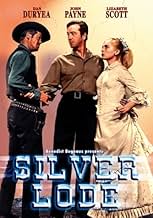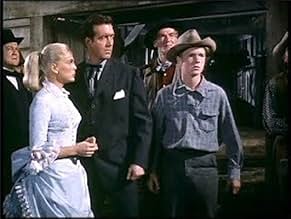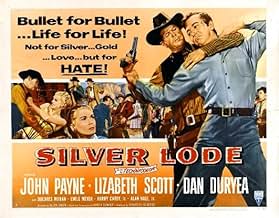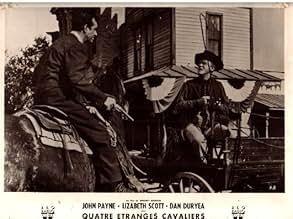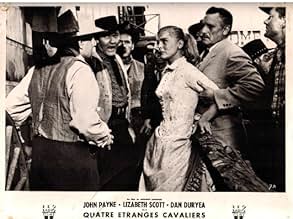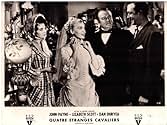NOTE IMDb
6,8/10
2,5 k
MA NOTE
Ajouter une intrigue dans votre langueIn the western town of Silver Lode, Dan Ballard is arrested for murder and theft by marshals, but he denies the charges and searches for the real culprit as the townsfolk gradually turn agai... Tout lireIn the western town of Silver Lode, Dan Ballard is arrested for murder and theft by marshals, but he denies the charges and searches for the real culprit as the townsfolk gradually turn against him.In the western town of Silver Lode, Dan Ballard is arrested for murder and theft by marshals, but he denies the charges and searches for the real culprit as the townsfolk gradually turn against him.
Walter Bacon
- Townsman
- (non crédité)
Edgar Barrier
- Thad Taylor
- (non crédité)
Marshall Bradford
- Townsman
- (non crédité)
Avis à la une
Silver Lode (1954) :
Brief Review -
Allan Dwan's underrated and misunderstood western gem. I wasn't aware that a film with similar effects as "Ox Bow Incident" (1943) was made in the 1950s and almost became a gem of a film. John Payne was no John Wayne, so forget about the lead being impactful, but I am really in love with the script. The film is about Dan, who is arrested on his wedding day (which also happens to be 4th July), and asks for two hours to prove his innocence. The charges against him are murder and theft of $20,000, which is more than enough to hang him. Marshall McCarthy has brought all the papers, and they are in order, but he is more into revenge on his brother than arrest and justice. Between these two hours, the entire town goes against Dan, as several killings are blamed on him. It goes up to the mob-lynching stage, and then Dan has to do some killings to prove his innocence. It's an intelligent film despite its quick-go and far-fetched conflicts that take place one after another during one hour. The only two people who believe in Dan are his soon-to-be wife and a bar dancer who loves him. They help him in the process of getting a message sent to the US marshal, but by that time, it's too late. The climax sees Dan standing in a jam, up against McCarthy and the entire town, which used to respect him an hour ago. That's how the human mindset changes within a few minutes. A moment ago, they used to respect him, and a moment later, they wanted to kill him. The performances and production are quite so-so, while the direction seemed fine. The film deserved better dialogues and a better score. Nevertheless, the story and screenplay themselves make it a MUST WATCH. I can't believe this was called "misfire" by contemporary critics and has remained so underrated for years. I personally liked it very much and would recommend it to others.
RATING - 7/10*
By - #samthebestest.
Allan Dwan's underrated and misunderstood western gem. I wasn't aware that a film with similar effects as "Ox Bow Incident" (1943) was made in the 1950s and almost became a gem of a film. John Payne was no John Wayne, so forget about the lead being impactful, but I am really in love with the script. The film is about Dan, who is arrested on his wedding day (which also happens to be 4th July), and asks for two hours to prove his innocence. The charges against him are murder and theft of $20,000, which is more than enough to hang him. Marshall McCarthy has brought all the papers, and they are in order, but he is more into revenge on his brother than arrest and justice. Between these two hours, the entire town goes against Dan, as several killings are blamed on him. It goes up to the mob-lynching stage, and then Dan has to do some killings to prove his innocence. It's an intelligent film despite its quick-go and far-fetched conflicts that take place one after another during one hour. The only two people who believe in Dan are his soon-to-be wife and a bar dancer who loves him. They help him in the process of getting a message sent to the US marshal, but by that time, it's too late. The climax sees Dan standing in a jam, up against McCarthy and the entire town, which used to respect him an hour ago. That's how the human mindset changes within a few minutes. A moment ago, they used to respect him, and a moment later, they wanted to kill him. The performances and production are quite so-so, while the direction seemed fine. The film deserved better dialogues and a better score. Nevertheless, the story and screenplay themselves make it a MUST WATCH. I can't believe this was called "misfire" by contemporary critics and has remained so underrated for years. I personally liked it very much and would recommend it to others.
RATING - 7/10*
By - #samthebestest.
Released in 1954 - Silver Lode stands tall as a pretty decent Western in its own right. True. Its familiar story can easily be compared to "High Noon" in many ways, but, nevertheless, it is an entertaining cowboy flick, all the same.
Filmed with the obvious restrictions of its B-movie budget, this vintage, Technicolor Western tells the tale of Dan Ballard, a decent man (relatively new to town) who (on his wedding day, which also happens to be the 4th of July) finds himself being accused of cold-blooded murder and the theft of $20,000.
This unjust accusation is leveled at Ballard by Marshal McCarty, a very mean and forceful lawman, who unexpectedly arrives in town from Discovery, California, in the company of his 3 rough-looking deputies.
Needless to say, an intense conflict takes place that quickly escalates into an all-out gunfight which has almost every able-bodied man in town involved (and even some of the women).
With his life now hanging delicately in the balance, Ballard soon finds himself a hunted man in his own hometown. A vicious, mindless mob-mentality takes over as the citizens of Silver Lode pursue Ballard with a blind, hateful vengeance.
Silver Lode was a film that was very much a product of its time. It was produced during the "McCarthy" era, when film producers, writers and actors were called to account during a (literal) political witch hunt.
This film's screenplay reflects the concerns of the American people of that time in regards to matters such as truth and liberty in what they believed to be a free society.
With a running time of only 80 minutes, Silver Lode moved along at a really good clip. Its cast included John Payne, Dan Duryea, Harry Carey Jr., and Lizabeth Scott.
Filmed with the obvious restrictions of its B-movie budget, this vintage, Technicolor Western tells the tale of Dan Ballard, a decent man (relatively new to town) who (on his wedding day, which also happens to be the 4th of July) finds himself being accused of cold-blooded murder and the theft of $20,000.
This unjust accusation is leveled at Ballard by Marshal McCarty, a very mean and forceful lawman, who unexpectedly arrives in town from Discovery, California, in the company of his 3 rough-looking deputies.
Needless to say, an intense conflict takes place that quickly escalates into an all-out gunfight which has almost every able-bodied man in town involved (and even some of the women).
With his life now hanging delicately in the balance, Ballard soon finds himself a hunted man in his own hometown. A vicious, mindless mob-mentality takes over as the citizens of Silver Lode pursue Ballard with a blind, hateful vengeance.
Silver Lode was a film that was very much a product of its time. It was produced during the "McCarthy" era, when film producers, writers and actors were called to account during a (literal) political witch hunt.
This film's screenplay reflects the concerns of the American people of that time in regards to matters such as truth and liberty in what they believed to be a free society.
With a running time of only 80 minutes, Silver Lode moved along at a really good clip. Its cast included John Payne, Dan Duryea, Harry Carey Jr., and Lizabeth Scott.
Dan Duryea is the reason I decided to watch this western and he is wonderful but far from the only reason I rate the movie an 8. The action starts with Dan and three other riders (Harry Carey Jr and Alan Hale Jr for gosh sakes... you know you're in for a good time) riding into the town of Silver Lode on forth of July. They're looking for the man named "Dan Ballard" but everyone they ask gives them the cold shoulder, one remarks they know a gunfighter when they see one. Turns out Dan is a federal marshal named Ned McCarty (other reviews have noted the McCarthy similarity and I agree with them on that) come to take Ballard -- solidly played by John Payne -- prisoner back to California for a murder rap. The victim is, it turns out, McCarty's brother and there is also a matter of $20,000 stolen at the same time.
At first the town's people are solidly behind Ballard but gradually they come around to bow McCarty's assumed authority and turn against Ballard. This is done rather well, not nearly as heavy handedly as might be. Many reviewers have noted the similarity to "High Noon", it's sort of a "High Noon" in reverse. While that's mighty high company the comparison is not out of line and the wonderful direction of Allan Dwan makes up for the lower production values. This is a good story, well made and worth looking for.
At first the town's people are solidly behind Ballard but gradually they come around to bow McCarty's assumed authority and turn against Ballard. This is done rather well, not nearly as heavy handedly as might be. Many reviewers have noted the similarity to "High Noon", it's sort of a "High Noon" in reverse. While that's mighty high company the comparison is not out of line and the wonderful direction of Allan Dwan makes up for the lower production values. This is a good story, well made and worth looking for.
What could easily have been just another low-budget Western oater or, worse still, the poor man's HIGH NOON (1952), is turned by excellent scripting (atypically the work of a woman!) and direction into a true gem of the genre during its golden age. In fact, the film wears its anti-Red Scare intentions proudly on its sleeve by actually naming its chief villain (Dan Duryea in formidable form) McCarthy and making him an outlaw posing as a fake U.S. Marshal! Reformed gunfighter hero John Payne (in his first of four movies for veteran director Dwan) has his 4th of July wedding (to local belle Lizabeth Scott) disrupted by the arrival in town of Duryea and his men (including Stuart Whitman and Harry Carey Jr.) claiming to have a warrant for his arrest for killing Duryea's brother and absconding with the sum of $20,000. So far so conventional plot-wise but what is remarkable here is the way that the film-makers chose to employ the townspeople who are constantly following the protagonists around the streets of Silver Lode, at first forcibly siding with Payne (to the point of holding Duryea et al at gunpoint) but, with time, being swayed by the latter's lies and an unfortunate series of events that lead them to believe Payne guilty of murdering their sheriff (Emile Meyer) and one of the marshals, as well as wounding Scott's hot-headed brother. Aiding Payne, apart from the unwavering Scott (of course), is his ex-flame, sultry saloon gal (Dolores Moran, the wife of producer Benedict Bogeaus and whose last film this proved to be) who spits one-liner put-downs to hero, villain and everyone in between; I really liked her character and, apparently, so did Dwan because he opted to close the film on the image of her running frantically clenching the all-important telegraphic confirmation (Duryea's men had intuitively cut the lines beforehand) of Payne's claims of innocence. However, in view of the film being a thinly-veiled allegory on the ongoing witch-hunts, it is a telling comment on the relative nature of truth that the girls had already won the day by forcing the gullible telegraph official to write down a false reply. The expected climactic confrontation between Payne and Duryea, then, takes place inside a bell tower with the latter's bullet ultimately ricocheting on himself in God-like retribution making for a doubly ironic ending to a film (beautifully shot in color by the great John Alton) that had held its audience entranced for all of 77 breathless minutes.
I must admit here and now that I have not seen this film. However, in my research of such B-Westerns, I found that this film was originally shot in 3-D. That has not been mentioned anywhere.
Perhaps the IMDb crew can investigate and make the appropriate notation wherever it is that such notations are made.
I certainly would like to see this film, as it appears to have an interesting cast... John Payne, Dan Duryea, and Lizabeth Scott usually do good work, and the other reviews have generally been positive.
From the reviews, this could perhaps be one of the best 3-D movies made during the 3-D movie craze in the early 1950's... Hondo being another one that could be better.
Perhaps the IMDb crew can investigate and make the appropriate notation wherever it is that such notations are made.
I certainly would like to see this film, as it appears to have an interesting cast... John Payne, Dan Duryea, and Lizabeth Scott usually do good work, and the other reviews have generally been positive.
From the reviews, this could perhaps be one of the best 3-D movies made during the 3-D movie craze in the early 1950's... Hondo being another one that could be better.
Le saviez-vous
- AnecdotesDolores Moran, who plays "Dolly" in the film, was married to producer Benedict Bogeaus at the time of production. It was her last film.
- GaffesWhen Ballard hides near a haystack outside the Evans house, his shadow and the shadows of his pursuers fall on to the painted backdrop, revealing it as canvas and not a real landscape.
- Citations
Dan Ballard: This man's accused me of murder.
- Crédits fousThe opening RKO Radio logo is in black and white.
Meilleurs choix
Connectez-vous pour évaluer et suivre la liste de favoris afin de recevoir des recommandations personnalisées
- How long is Silver Lode?Alimenté par Alexa
Détails
- Date de sortie
- Pays d’origine
- Langue
- Aussi connu sous le nom de
- Silver Lode
- Lieux de tournage
- Sociétés de production
- Voir plus de crédits d'entreprise sur IMDbPro
- Durée
- 1h 21min(81 min)
Contribuer à cette page
Suggérer une modification ou ajouter du contenu manquant

